Analysis of Alphabet Inc.'s International Business Challenges
VerifiedAdded on 2022/10/12
|8
|2098
|156
Report
AI Summary
This report provides an analysis of Alphabet Inc., formerly Google, focusing on key issues in its international business operations. The report identifies several challenges, including a decline in online advertising market share, regulatory pressures, issues with bad advertisements and content, competition in self-driving technology, and talent retention. To address these issues, the report applies various marketing models and frameworks, such as the BCG matrix, Porter's five forces, the marketing mix (4Ps), and the Ansoff matrix. These models are used to suggest strategies for improving market share, adjusting to regulatory pressures, improving advertising quality, and developing non-advertising products. The report concludes that Alphabet Inc. needs to leverage these models to gain a competitive advantage in its industry. The report offers insights into the application of strategic marketing and business development concepts within a multinational corporation.
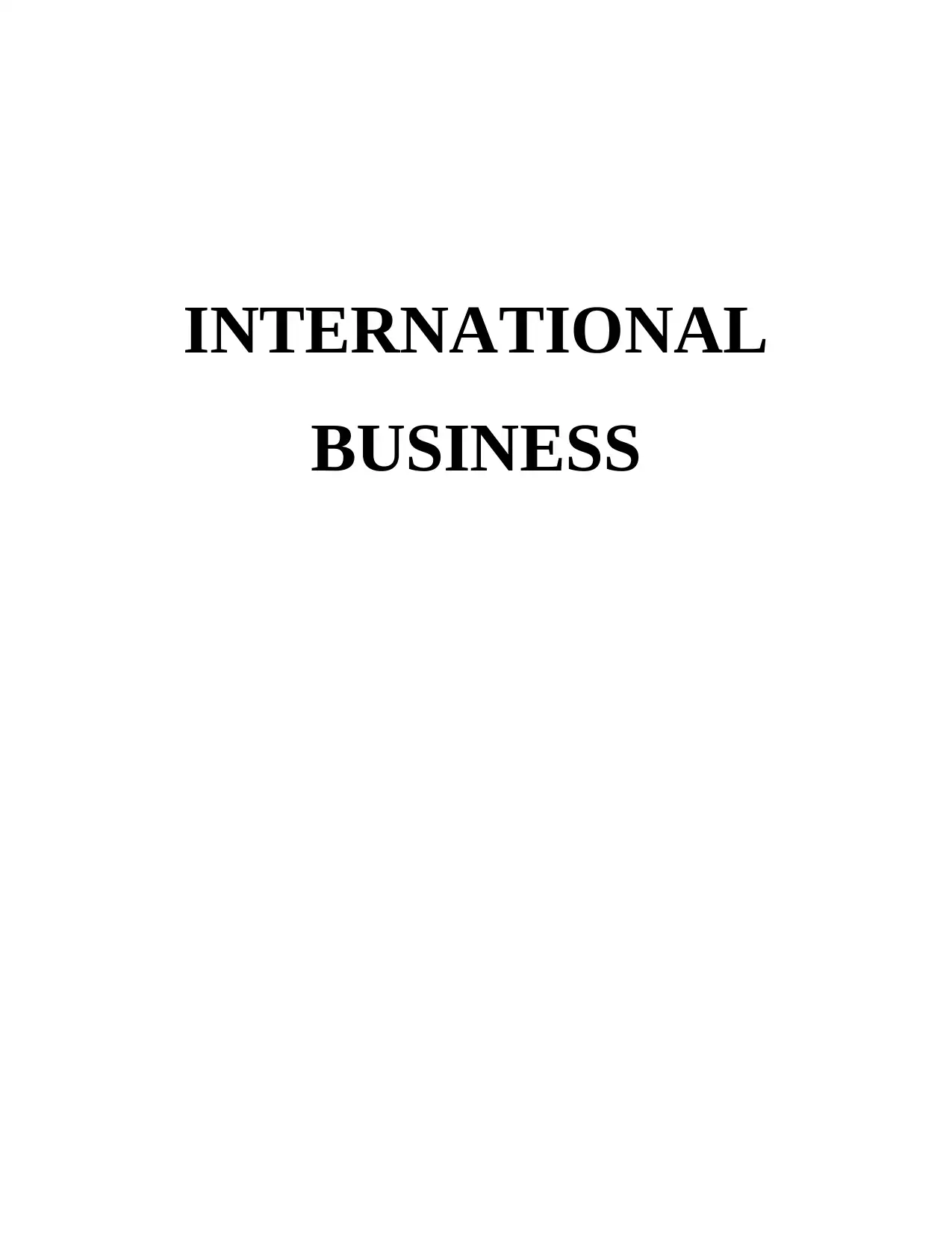
INTERNATIONAL
BUSINESS
BUSINESS
Paraphrase This Document
Need a fresh take? Get an instant paraphrase of this document with our AI Paraphraser
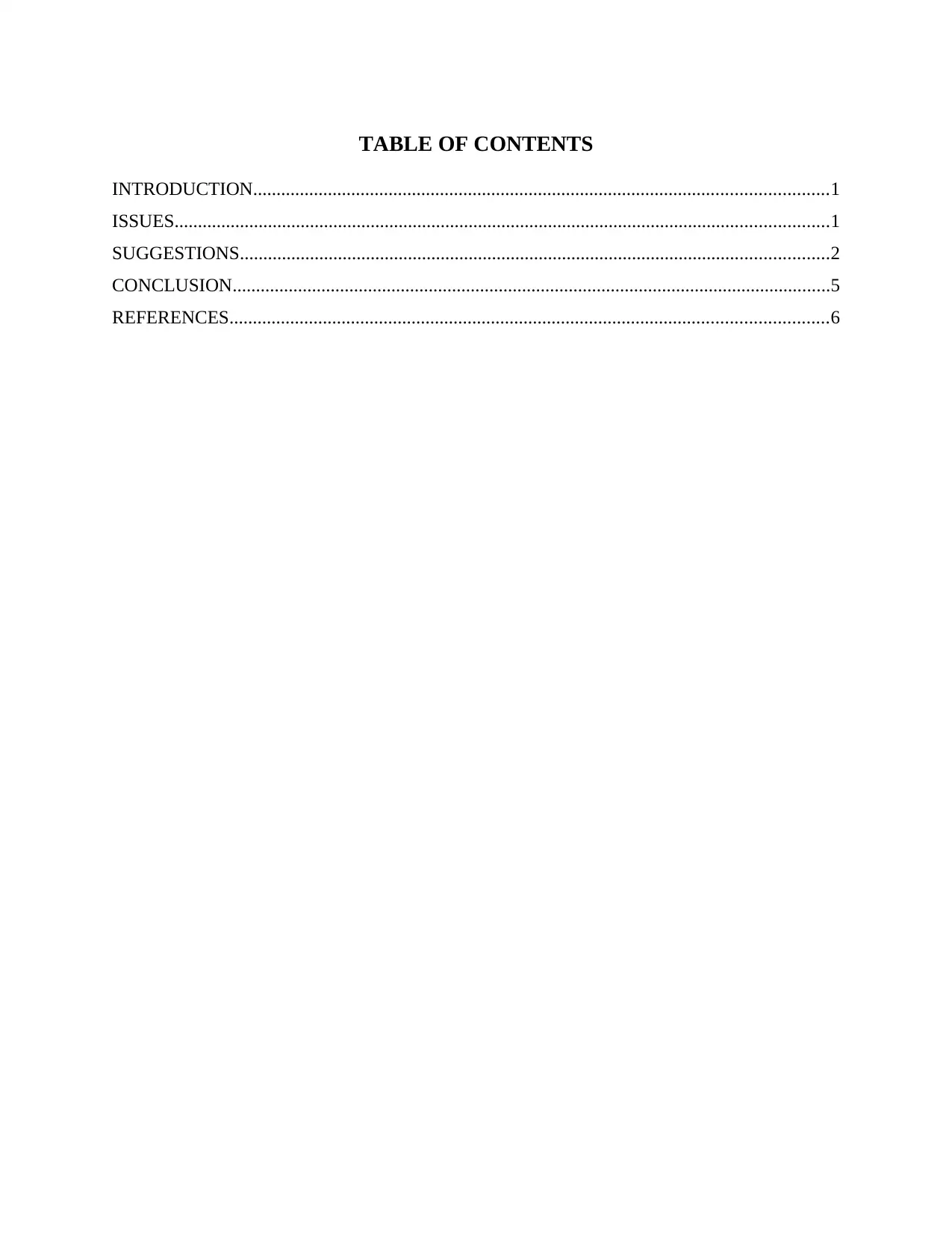
TABLE OF CONTENTS
INTRODUCTION...........................................................................................................................1
ISSUES............................................................................................................................................1
SUGGESTIONS..............................................................................................................................2
CONCLUSION................................................................................................................................5
REFERENCES................................................................................................................................6
INTRODUCTION...........................................................................................................................1
ISSUES............................................................................................................................................1
SUGGESTIONS..............................................................................................................................2
CONCLUSION................................................................................................................................5
REFERENCES................................................................................................................................6
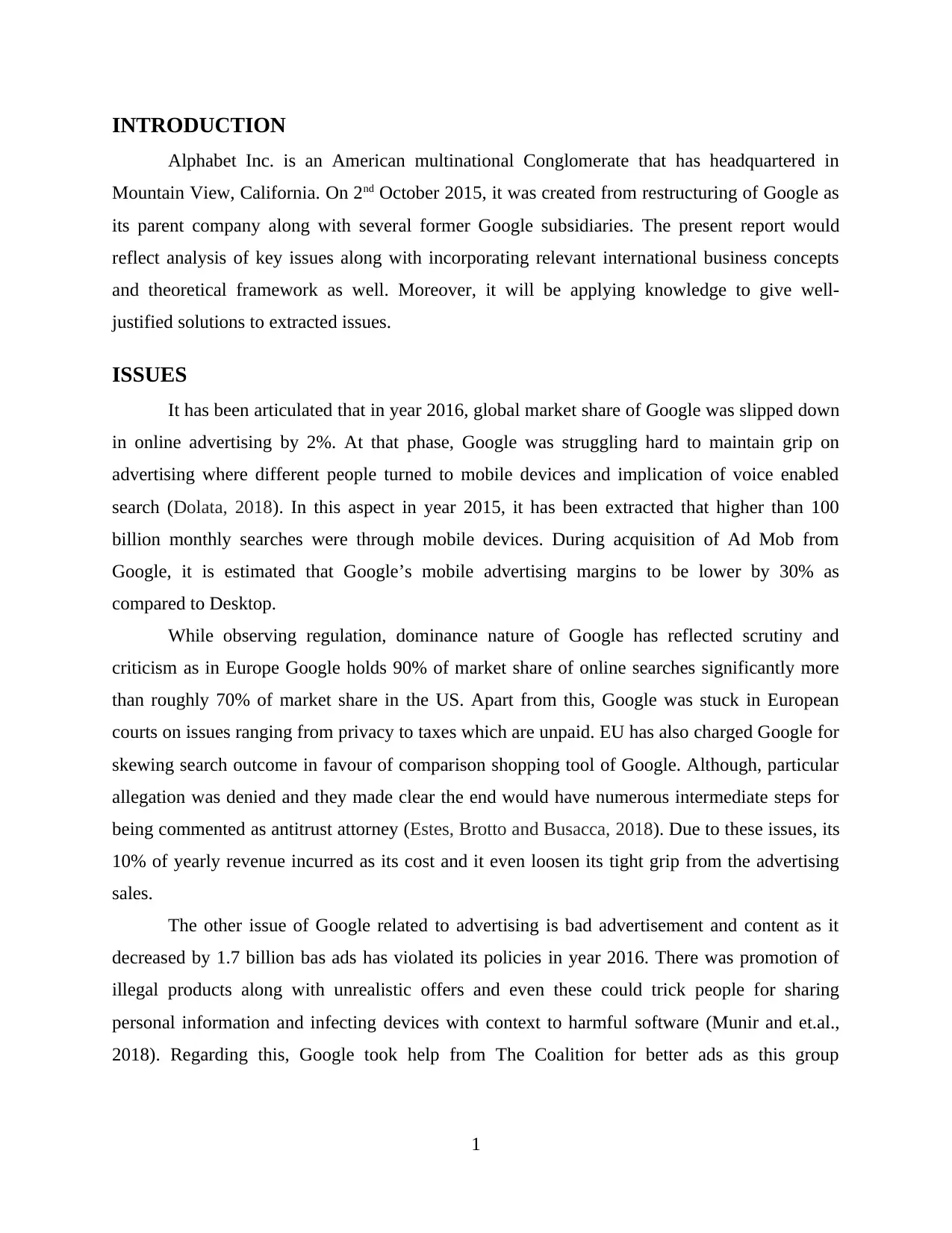
INTRODUCTION
Alphabet Inc. is an American multinational Conglomerate that has headquartered in
Mountain View, California. On 2nd October 2015, it was created from restructuring of Google as
its parent company along with several former Google subsidiaries. The present report would
reflect analysis of key issues along with incorporating relevant international business concepts
and theoretical framework as well. Moreover, it will be applying knowledge to give well-
justified solutions to extracted issues.
ISSUES
It has been articulated that in year 2016, global market share of Google was slipped down
in online advertising by 2%. At that phase, Google was struggling hard to maintain grip on
advertising where different people turned to mobile devices and implication of voice enabled
search (Dolata, 2018). In this aspect in year 2015, it has been extracted that higher than 100
billion monthly searches were through mobile devices. During acquisition of Ad Mob from
Google, it is estimated that Google’s mobile advertising margins to be lower by 30% as
compared to Desktop.
While observing regulation, dominance nature of Google has reflected scrutiny and
criticism as in Europe Google holds 90% of market share of online searches significantly more
than roughly 70% of market share in the US. Apart from this, Google was stuck in European
courts on issues ranging from privacy to taxes which are unpaid. EU has also charged Google for
skewing search outcome in favour of comparison shopping tool of Google. Although, particular
allegation was denied and they made clear the end would have numerous intermediate steps for
being commented as antitrust attorney (Estes, Brotto and Busacca, 2018). Due to these issues, its
10% of yearly revenue incurred as its cost and it even loosen its tight grip from the advertising
sales.
The other issue of Google related to advertising is bad advertisement and content as it
decreased by 1.7 billion bas ads has violated its policies in year 2016. There was promotion of
illegal products along with unrealistic offers and even these could trick people for sharing
personal information and infecting devices with context to harmful software (Munir and et.al.,
2018). Regarding this, Google took help from The Coalition for better ads as this group
1
Alphabet Inc. is an American multinational Conglomerate that has headquartered in
Mountain View, California. On 2nd October 2015, it was created from restructuring of Google as
its parent company along with several former Google subsidiaries. The present report would
reflect analysis of key issues along with incorporating relevant international business concepts
and theoretical framework as well. Moreover, it will be applying knowledge to give well-
justified solutions to extracted issues.
ISSUES
It has been articulated that in year 2016, global market share of Google was slipped down
in online advertising by 2%. At that phase, Google was struggling hard to maintain grip on
advertising where different people turned to mobile devices and implication of voice enabled
search (Dolata, 2018). In this aspect in year 2015, it has been extracted that higher than 100
billion monthly searches were through mobile devices. During acquisition of Ad Mob from
Google, it is estimated that Google’s mobile advertising margins to be lower by 30% as
compared to Desktop.
While observing regulation, dominance nature of Google has reflected scrutiny and
criticism as in Europe Google holds 90% of market share of online searches significantly more
than roughly 70% of market share in the US. Apart from this, Google was stuck in European
courts on issues ranging from privacy to taxes which are unpaid. EU has also charged Google for
skewing search outcome in favour of comparison shopping tool of Google. Although, particular
allegation was denied and they made clear the end would have numerous intermediate steps for
being commented as antitrust attorney (Estes, Brotto and Busacca, 2018). Due to these issues, its
10% of yearly revenue incurred as its cost and it even loosen its tight grip from the advertising
sales.
The other issue of Google related to advertising is bad advertisement and content as it
decreased by 1.7 billion bas ads has violated its policies in year 2016. There was promotion of
illegal products along with unrealistic offers and even these could trick people for sharing
personal information and infecting devices with context to harmful software (Munir and et.al.,
2018). Regarding this, Google took help from The Coalition for better ads as this group
1
⊘ This is a preview!⊘
Do you want full access?
Subscribe today to unlock all pages.

Trusted by 1+ million students worldwide
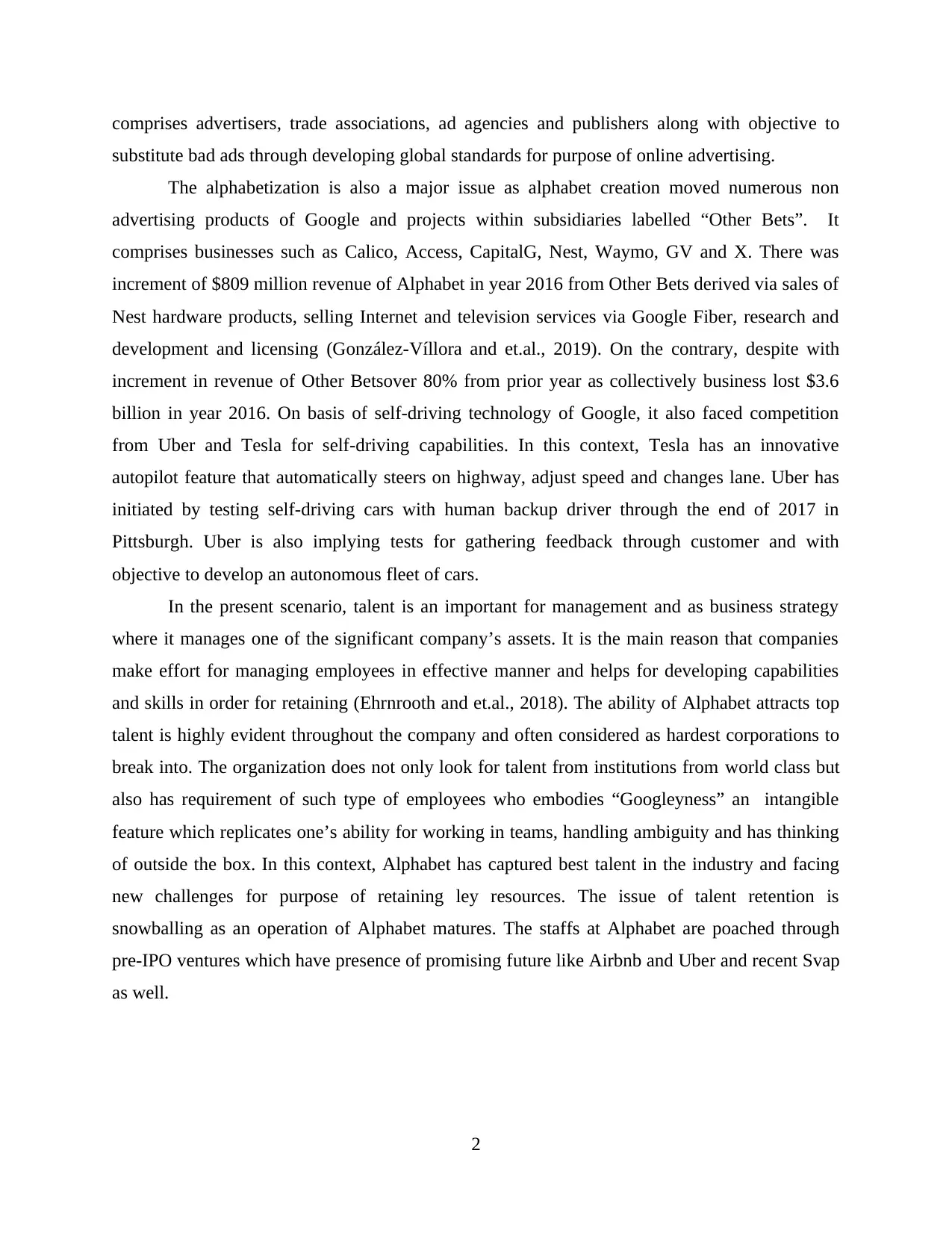
comprises advertisers, trade associations, ad agencies and publishers along with objective to
substitute bad ads through developing global standards for purpose of online advertising.
The alphabetization is also a major issue as alphabet creation moved numerous non
advertising products of Google and projects within subsidiaries labelled “Other Bets”. It
comprises businesses such as Calico, Access, CapitalG, Nest, Waymo, GV and X. There was
increment of $809 million revenue of Alphabet in year 2016 from Other Bets derived via sales of
Nest hardware products, selling Internet and television services via Google Fiber, research and
development and licensing (González-Víllora and et.al., 2019). On the contrary, despite with
increment in revenue of Other Betsover 80% from prior year as collectively business lost $3.6
billion in year 2016. On basis of self-driving technology of Google, it also faced competition
from Uber and Tesla for self-driving capabilities. In this context, Tesla has an innovative
autopilot feature that automatically steers on highway, adjust speed and changes lane. Uber has
initiated by testing self-driving cars with human backup driver through the end of 2017 in
Pittsburgh. Uber is also implying tests for gathering feedback through customer and with
objective to develop an autonomous fleet of cars.
In the present scenario, talent is an important for management and as business strategy
where it manages one of the significant company’s assets. It is the main reason that companies
make effort for managing employees in effective manner and helps for developing capabilities
and skills in order for retaining (Ehrnrooth and et.al., 2018). The ability of Alphabet attracts top
talent is highly evident throughout the company and often considered as hardest corporations to
break into. The organization does not only look for talent from institutions from world class but
also has requirement of such type of employees who embodies “Googleyness” an intangible
feature which replicates one’s ability for working in teams, handling ambiguity and has thinking
of outside the box. In this context, Alphabet has captured best talent in the industry and facing
new challenges for purpose of retaining ley resources. The issue of talent retention is
snowballing as an operation of Alphabet matures. The staffs at Alphabet are poached through
pre-IPO ventures which have presence of promising future like Airbnb and Uber and recent Svap
as well.
2
substitute bad ads through developing global standards for purpose of online advertising.
The alphabetization is also a major issue as alphabet creation moved numerous non
advertising products of Google and projects within subsidiaries labelled “Other Bets”. It
comprises businesses such as Calico, Access, CapitalG, Nest, Waymo, GV and X. There was
increment of $809 million revenue of Alphabet in year 2016 from Other Bets derived via sales of
Nest hardware products, selling Internet and television services via Google Fiber, research and
development and licensing (González-Víllora and et.al., 2019). On the contrary, despite with
increment in revenue of Other Betsover 80% from prior year as collectively business lost $3.6
billion in year 2016. On basis of self-driving technology of Google, it also faced competition
from Uber and Tesla for self-driving capabilities. In this context, Tesla has an innovative
autopilot feature that automatically steers on highway, adjust speed and changes lane. Uber has
initiated by testing self-driving cars with human backup driver through the end of 2017 in
Pittsburgh. Uber is also implying tests for gathering feedback through customer and with
objective to develop an autonomous fleet of cars.
In the present scenario, talent is an important for management and as business strategy
where it manages one of the significant company’s assets. It is the main reason that companies
make effort for managing employees in effective manner and helps for developing capabilities
and skills in order for retaining (Ehrnrooth and et.al., 2018). The ability of Alphabet attracts top
talent is highly evident throughout the company and often considered as hardest corporations to
break into. The organization does not only look for talent from institutions from world class but
also has requirement of such type of employees who embodies “Googleyness” an intangible
feature which replicates one’s ability for working in teams, handling ambiguity and has thinking
of outside the box. In this context, Alphabet has captured best talent in the industry and facing
new challenges for purpose of retaining ley resources. The issue of talent retention is
snowballing as an operation of Alphabet matures. The staffs at Alphabet are poached through
pre-IPO ventures which have presence of promising future like Airbnb and Uber and recent Svap
as well.
2
Paraphrase This Document
Need a fresh take? Get an instant paraphrase of this document with our AI Paraphraser
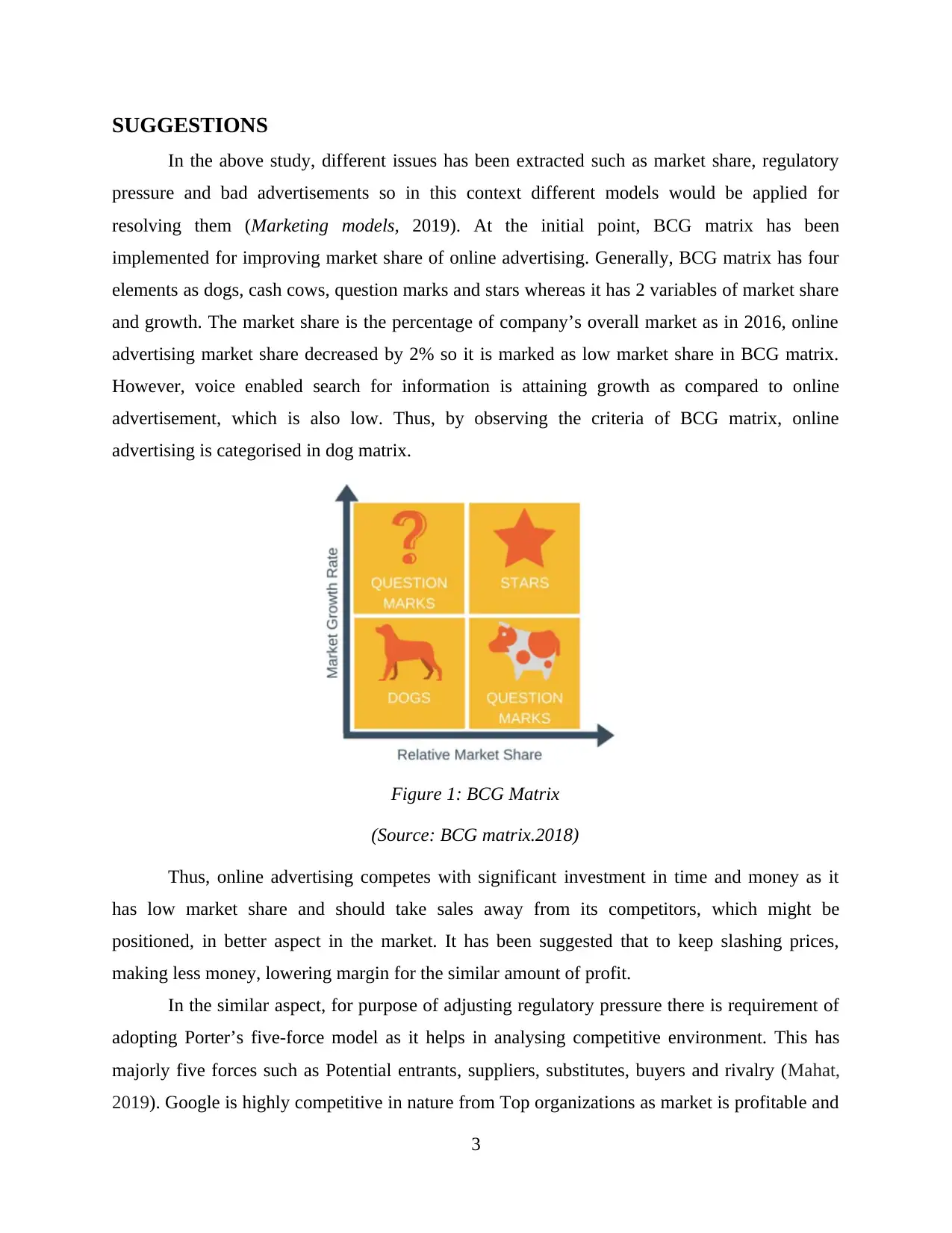
SUGGESTIONS
In the above study, different issues has been extracted such as market share, regulatory
pressure and bad advertisements so in this context different models would be applied for
resolving them (Marketing models, 2019). At the initial point, BCG matrix has been
implemented for improving market share of online advertising. Generally, BCG matrix has four
elements as dogs, cash cows, question marks and stars whereas it has 2 variables of market share
and growth. The market share is the percentage of company’s overall market as in 2016, online
advertising market share decreased by 2% so it is marked as low market share in BCG matrix.
However, voice enabled search for information is attaining growth as compared to online
advertisement, which is also low. Thus, by observing the criteria of BCG matrix, online
advertising is categorised in dog matrix.
Figure 1: BCG Matrix
(Source: BCG matrix.2018)
Thus, online advertising competes with significant investment in time and money as it
has low market share and should take sales away from its competitors, which might be
positioned, in better aspect in the market. It has been suggested that to keep slashing prices,
making less money, lowering margin for the similar amount of profit.
In the similar aspect, for purpose of adjusting regulatory pressure there is requirement of
adopting Porter’s five-force model as it helps in analysing competitive environment. This has
majorly five forces such as Potential entrants, suppliers, substitutes, buyers and rivalry (Mahat,
2019). Google is highly competitive in nature from Top organizations as market is profitable and
3
In the above study, different issues has been extracted such as market share, regulatory
pressure and bad advertisements so in this context different models would be applied for
resolving them (Marketing models, 2019). At the initial point, BCG matrix has been
implemented for improving market share of online advertising. Generally, BCG matrix has four
elements as dogs, cash cows, question marks and stars whereas it has 2 variables of market share
and growth. The market share is the percentage of company’s overall market as in 2016, online
advertising market share decreased by 2% so it is marked as low market share in BCG matrix.
However, voice enabled search for information is attaining growth as compared to online
advertisement, which is also low. Thus, by observing the criteria of BCG matrix, online
advertising is categorised in dog matrix.
Figure 1: BCG Matrix
(Source: BCG matrix.2018)
Thus, online advertising competes with significant investment in time and money as it
has low market share and should take sales away from its competitors, which might be
positioned, in better aspect in the market. It has been suggested that to keep slashing prices,
making less money, lowering margin for the similar amount of profit.
In the similar aspect, for purpose of adjusting regulatory pressure there is requirement of
adopting Porter’s five-force model as it helps in analysing competitive environment. This has
majorly five forces such as Potential entrants, suppliers, substitutes, buyers and rivalry (Mahat,
2019). Google is highly competitive in nature from Top organizations as market is profitable and
3
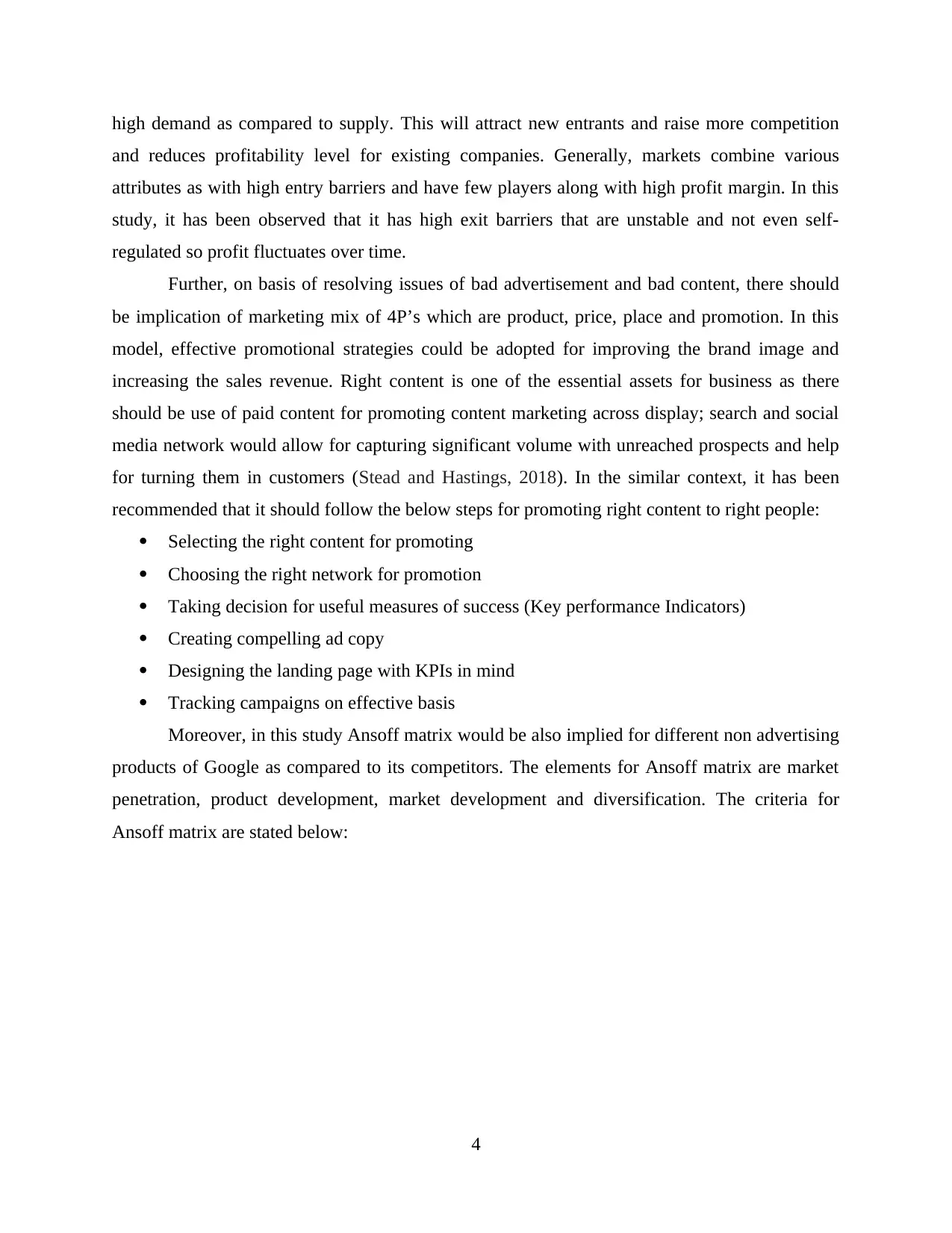
high demand as compared to supply. This will attract new entrants and raise more competition
and reduces profitability level for existing companies. Generally, markets combine various
attributes as with high entry barriers and have few players along with high profit margin. In this
study, it has been observed that it has high exit barriers that are unstable and not even self-
regulated so profit fluctuates over time.
Further, on basis of resolving issues of bad advertisement and bad content, there should
be implication of marketing mix of 4P’s which are product, price, place and promotion. In this
model, effective promotional strategies could be adopted for improving the brand image and
increasing the sales revenue. Right content is one of the essential assets for business as there
should be use of paid content for promoting content marketing across display; search and social
media network would allow for capturing significant volume with unreached prospects and help
for turning them in customers (Stead and Hastings, 2018). In the similar context, it has been
recommended that it should follow the below steps for promoting right content to right people:
Selecting the right content for promoting
Choosing the right network for promotion
Taking decision for useful measures of success (Key performance Indicators)
Creating compelling ad copy
Designing the landing page with KPIs in mind
Tracking campaigns on effective basis
Moreover, in this study Ansoff matrix would be also implied for different non advertising
products of Google as compared to its competitors. The elements for Ansoff matrix are market
penetration, product development, market development and diversification. The criteria for
Ansoff matrix are stated below:
4
and reduces profitability level for existing companies. Generally, markets combine various
attributes as with high entry barriers and have few players along with high profit margin. In this
study, it has been observed that it has high exit barriers that are unstable and not even self-
regulated so profit fluctuates over time.
Further, on basis of resolving issues of bad advertisement and bad content, there should
be implication of marketing mix of 4P’s which are product, price, place and promotion. In this
model, effective promotional strategies could be adopted for improving the brand image and
increasing the sales revenue. Right content is one of the essential assets for business as there
should be use of paid content for promoting content marketing across display; search and social
media network would allow for capturing significant volume with unreached prospects and help
for turning them in customers (Stead and Hastings, 2018). In the similar context, it has been
recommended that it should follow the below steps for promoting right content to right people:
Selecting the right content for promoting
Choosing the right network for promotion
Taking decision for useful measures of success (Key performance Indicators)
Creating compelling ad copy
Designing the landing page with KPIs in mind
Tracking campaigns on effective basis
Moreover, in this study Ansoff matrix would be also implied for different non advertising
products of Google as compared to its competitors. The elements for Ansoff matrix are market
penetration, product development, market development and diversification. The criteria for
Ansoff matrix are stated below:
4
⊘ This is a preview!⊘
Do you want full access?
Subscribe today to unlock all pages.

Trusted by 1+ million students worldwide
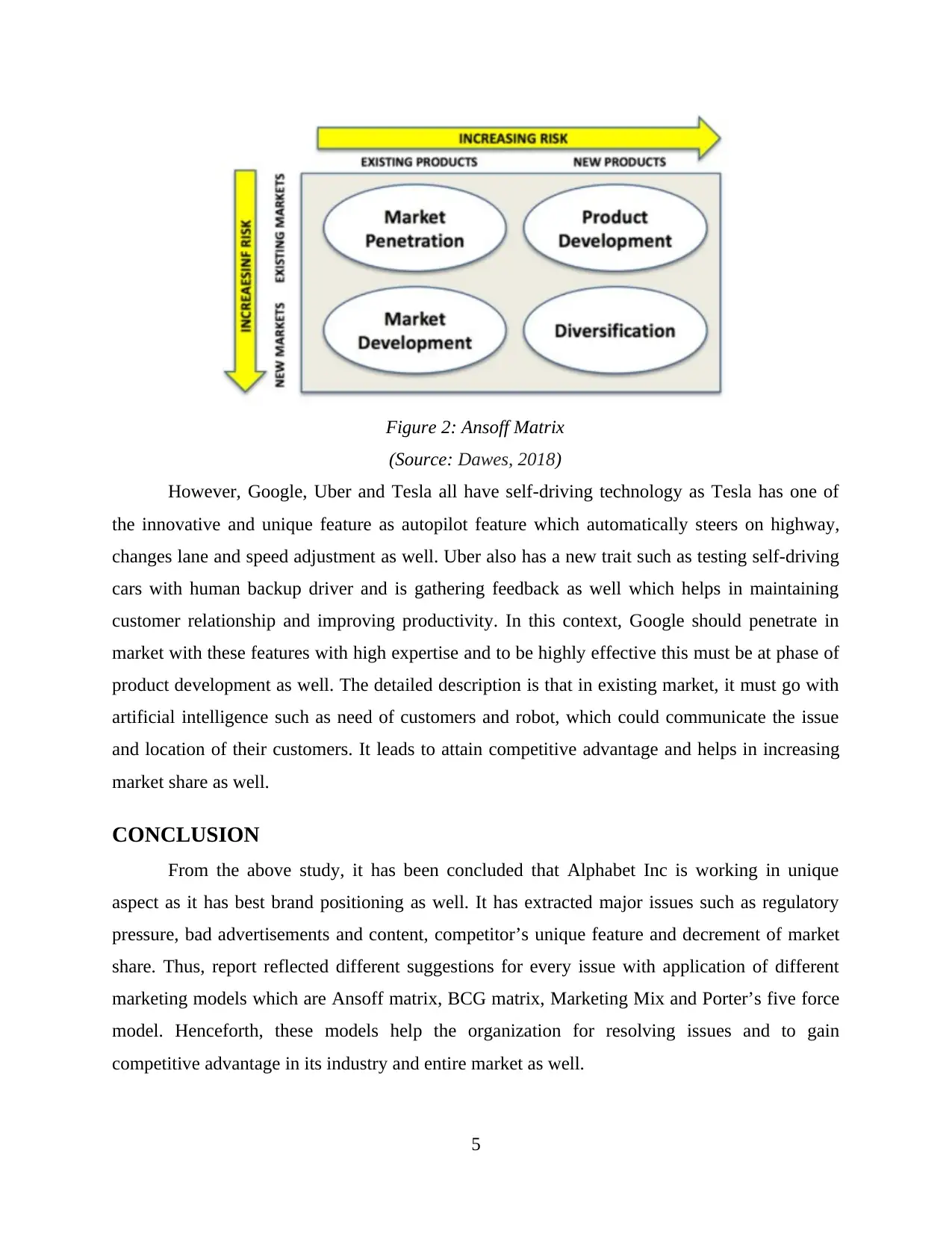
Figure 2: Ansoff Matrix
(Source: Dawes, 2018)
However, Google, Uber and Tesla all have self-driving technology as Tesla has one of
the innovative and unique feature as autopilot feature which automatically steers on highway,
changes lane and speed adjustment as well. Uber also has a new trait such as testing self-driving
cars with human backup driver and is gathering feedback as well which helps in maintaining
customer relationship and improving productivity. In this context, Google should penetrate in
market with these features with high expertise and to be highly effective this must be at phase of
product development as well. The detailed description is that in existing market, it must go with
artificial intelligence such as need of customers and robot, which could communicate the issue
and location of their customers. It leads to attain competitive advantage and helps in increasing
market share as well.
CONCLUSION
From the above study, it has been concluded that Alphabet Inc is working in unique
aspect as it has best brand positioning as well. It has extracted major issues such as regulatory
pressure, bad advertisements and content, competitor’s unique feature and decrement of market
share. Thus, report reflected different suggestions for every issue with application of different
marketing models which are Ansoff matrix, BCG matrix, Marketing Mix and Porter’s five force
model. Henceforth, these models help the organization for resolving issues and to gain
competitive advantage in its industry and entire market as well.
5
(Source: Dawes, 2018)
However, Google, Uber and Tesla all have self-driving technology as Tesla has one of
the innovative and unique feature as autopilot feature which automatically steers on highway,
changes lane and speed adjustment as well. Uber also has a new trait such as testing self-driving
cars with human backup driver and is gathering feedback as well which helps in maintaining
customer relationship and improving productivity. In this context, Google should penetrate in
market with these features with high expertise and to be highly effective this must be at phase of
product development as well. The detailed description is that in existing market, it must go with
artificial intelligence such as need of customers and robot, which could communicate the issue
and location of their customers. It leads to attain competitive advantage and helps in increasing
market share as well.
CONCLUSION
From the above study, it has been concluded that Alphabet Inc is working in unique
aspect as it has best brand positioning as well. It has extracted major issues such as regulatory
pressure, bad advertisements and content, competitor’s unique feature and decrement of market
share. Thus, report reflected different suggestions for every issue with application of different
marketing models which are Ansoff matrix, BCG matrix, Marketing Mix and Porter’s five force
model. Henceforth, these models help the organization for resolving issues and to gain
competitive advantage in its industry and entire market as well.
5
Paraphrase This Document
Need a fresh take? Get an instant paraphrase of this document with our AI Paraphraser
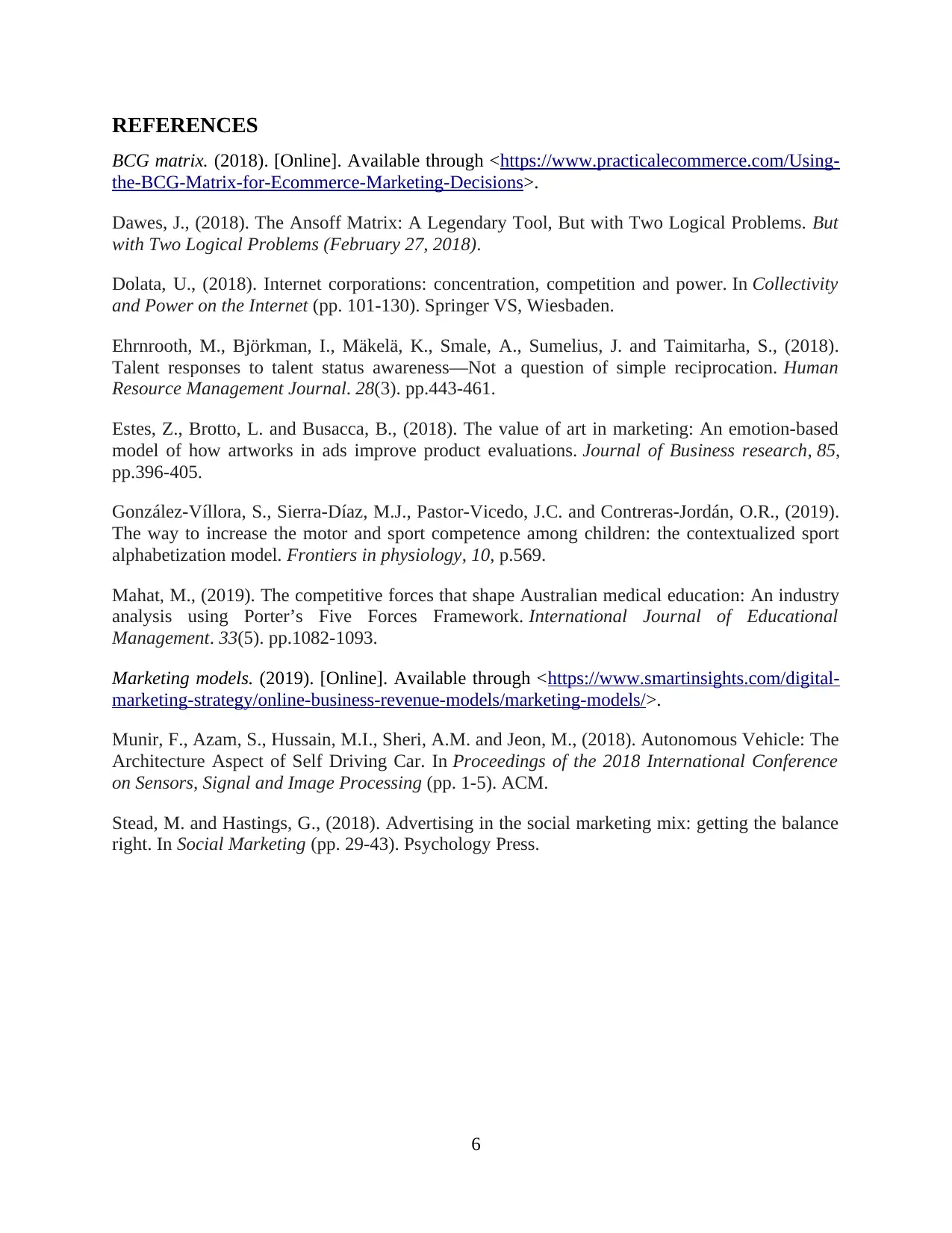
REFERENCES
BCG matrix. (2018). [Online]. Available through <https://www.practicalecommerce.com/Using-
the-BCG-Matrix-for-Ecommerce-Marketing-Decisions>.
Dawes, J., (2018). The Ansoff Matrix: A Legendary Tool, But with Two Logical Problems. But
with Two Logical Problems (February 27, 2018).
Dolata, U., (2018). Internet corporations: concentration, competition and power. In Collectivity
and Power on the Internet (pp. 101-130). Springer VS, Wiesbaden.
Ehrnrooth, M., Björkman, I., Mäkelä, K., Smale, A., Sumelius, J. and Taimitarha, S., (2018).
Talent responses to talent status awareness—Not a question of simple reciprocation. Human
Resource Management Journal. 28(3). pp.443-461.
Estes, Z., Brotto, L. and Busacca, B., (2018). The value of art in marketing: An emotion-based
model of how artworks in ads improve product evaluations. Journal of Business research, 85,
pp.396-405.
González-Víllora, S., Sierra-Díaz, M.J., Pastor-Vicedo, J.C. and Contreras-Jordán, O.R., (2019).
The way to increase the motor and sport competence among children: the contextualized sport
alphabetization model. Frontiers in physiology, 10, p.569.
Mahat, M., (2019). The competitive forces that shape Australian medical education: An industry
analysis using Porter’s Five Forces Framework. International Journal of Educational
Management. 33(5). pp.1082-1093.
Marketing models. (2019). [Online]. Available through <https://www.smartinsights.com/digital-
marketing-strategy/online-business-revenue-models/marketing-models/>.
Munir, F., Azam, S., Hussain, M.I., Sheri, A.M. and Jeon, M., (2018). Autonomous Vehicle: The
Architecture Aspect of Self Driving Car. In Proceedings of the 2018 International Conference
on Sensors, Signal and Image Processing (pp. 1-5). ACM.
Stead, M. and Hastings, G., (2018). Advertising in the social marketing mix: getting the balance
right. In Social Marketing (pp. 29-43). Psychology Press.
6
BCG matrix. (2018). [Online]. Available through <https://www.practicalecommerce.com/Using-
the-BCG-Matrix-for-Ecommerce-Marketing-Decisions>.
Dawes, J., (2018). The Ansoff Matrix: A Legendary Tool, But with Two Logical Problems. But
with Two Logical Problems (February 27, 2018).
Dolata, U., (2018). Internet corporations: concentration, competition and power. In Collectivity
and Power on the Internet (pp. 101-130). Springer VS, Wiesbaden.
Ehrnrooth, M., Björkman, I., Mäkelä, K., Smale, A., Sumelius, J. and Taimitarha, S., (2018).
Talent responses to talent status awareness—Not a question of simple reciprocation. Human
Resource Management Journal. 28(3). pp.443-461.
Estes, Z., Brotto, L. and Busacca, B., (2018). The value of art in marketing: An emotion-based
model of how artworks in ads improve product evaluations. Journal of Business research, 85,
pp.396-405.
González-Víllora, S., Sierra-Díaz, M.J., Pastor-Vicedo, J.C. and Contreras-Jordán, O.R., (2019).
The way to increase the motor and sport competence among children: the contextualized sport
alphabetization model. Frontiers in physiology, 10, p.569.
Mahat, M., (2019). The competitive forces that shape Australian medical education: An industry
analysis using Porter’s Five Forces Framework. International Journal of Educational
Management. 33(5). pp.1082-1093.
Marketing models. (2019). [Online]. Available through <https://www.smartinsights.com/digital-
marketing-strategy/online-business-revenue-models/marketing-models/>.
Munir, F., Azam, S., Hussain, M.I., Sheri, A.M. and Jeon, M., (2018). Autonomous Vehicle: The
Architecture Aspect of Self Driving Car. In Proceedings of the 2018 International Conference
on Sensors, Signal and Image Processing (pp. 1-5). ACM.
Stead, M. and Hastings, G., (2018). Advertising in the social marketing mix: getting the balance
right. In Social Marketing (pp. 29-43). Psychology Press.
6
1 out of 8
Related Documents
Your All-in-One AI-Powered Toolkit for Academic Success.
+13062052269
info@desklib.com
Available 24*7 on WhatsApp / Email
![[object Object]](/_next/static/media/star-bottom.7253800d.svg)
Unlock your academic potential
Copyright © 2020–2025 A2Z Services. All Rights Reserved. Developed and managed by ZUCOL.




